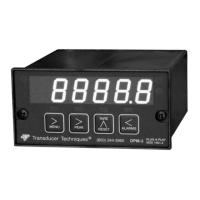- 4 -
The NEMA-4 (IP65) 1/8 DIN case is made of high impact 94V-0 UL-rated plastic. Mounting
is from the front of the panel and requires less than 110 mm behind the panel. All wiring is
by removable plugs conforming to UL61010C safety standards. All output options are
isolated from meter and power ground by 250 Vac minimum.
Alarm or setpoint control is provided by an optional relay board with two or four Form C 8A
mechanical relays or two or four Form A 120 mA solid state relays. The setpoints may be
latching or non-latching, be energized above or below the setpoint, or operate in a fail-safe
mode. The relays can operate from the filtered signal to reduce relay chatter or from the
unfiltered signal for fastest response. Snubber circuits and a programmable relay switching
time delay extend relay contact life.
An isolated analog output of 4-20 mA, 0-20 mA, 0-10V or -10 to +10V can be provided by an
optional analog output board. The output is linearized to the display and can operate from
the filtered or unfiltered signal input. It can be scaled via front panel pushbuttons or the
meter’s serial interface.
Optional RS232, RS485, or USB serial interfaces allow the DPM-3 to communicate bidirec-
tionally with computers, PLC’s or other digital devices. An optional USB-to-RS485 converter
board allows a primary DPM-3 to be interfaced to a computer and to be the device server for
a network of up to 31 other DPM-3’s on an RS485 bus, while itself retaining all capabilities
of a meter.
Windows-based software is available from Transducer Techniques to program our meter
and transmitters via a PC using the serial interface. This software can be downloaded at no
charge from www.transducertechniques.com/online-manuals.aspx. Please see Section 19
for details.
3. RECEIVING & UNPACKING
Your DPM-3 meter was carefully tested and inspected prior to shipment. Should the meter
be damaged in shipment, notify the freight carrier immediately. In the event the meter is not
configured as ordered or the unit is inoperable, return the unit to Transducer Techniques for
repair or replacement. Please include a detailed description of the problem.
4. SAFETY CONSIDERATIONS
Visually inspect the instrument for signs of damage. If damaged, do not attempt to operate.
Warning: Use of this equipment in a manner other than specified may impair the pro-
tection of the device and subject the user to a hazard. Visually inspect the unit for signs of
damage. If the unit is damaged, do not attempt to operate.
Caution:
This unit must be powered with AC (mains) from 85-264 Vac with the high voltage power
supply option, or 12-32 Vac (10-48 Vdc) with the low voltage power supply option. Verify

